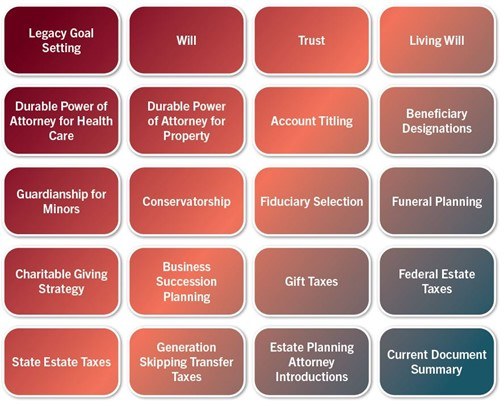The Strategy Map Vol 3: What is Estate Planning?
August 01, 2024
The CFP® Board defines estate planning as the legal planning that helps you control who will inherit your money and property, and who can make medical and financial decisions on your behalf if you are unable to do so yourself. Your estate consists of everything you own. Estate planning is simply getting the right stuff to the right people at the right time in the right way. There are legal documents such as wills, trusts, and powers of attorney to enable this. Without proper estate planning, your assets may distribute according to state law rather than your own wishes.

Exhibit 1 illustrates a variety of core estate planning documents and topic areas that we can help you consider for your unique situation. Do you want to leave a legacy for your family or support causes that are deeply important to you? Will your estate be subject to state or federal estate taxes? What can we do to minimize potential estate taxes now to ensure that you maximize the benefits to your loved ones?
To what extent are you willing and able to leave a legacy? Legacy planning can be an important piece of your estate plan. Through your estate plan, you create a roadmap that aligns your values and goals with how your assets will distribute at death. We can help quantify to what extent you are able to leave a legacy without jeopardizing the cash needs of your current lifestyle. We have the technology and resources to guide you through your current estate plan and actively partner with your estate planning attorney to put strategies in place that meet your legacy goals, whether that be benefiting your children or your favorite charities.
It’s important to understand the purpose of your core estate planning documents. First, let’s discuss the financial power of attorney. This is an estate planning document that allows you to grant another person (who is called your agent) power to act on your behalf in financial and legal matters. This grant can be immediate or can take effect if there is a triggering event. It gives broad powers to the “agent” to handle your financial affairs. There is also a separate estate planning document for the power of attorney for health care. Like the financial power of attorney, you designate another person (agent) to make medical decision on your behalf if you become mentally or physically incapacitated. While you are in good health, it is a good idea to decide what kind of care you would prefer if you were ever mentally or physically incapacitated.
The will or “last will and testament” is another core estate planning document. The purpose of this document is to allow you to specify who will receive your assets after you pass. It gives instructions to your executor or “personal representative” for the estate distribution. A will can also allow you to express any desires for funeral arrangements and/or guardianship for minors. A will can operate very differently if you already have a trust in place. This is called a pour-over will and ensures that assets not already included in your trust at the time of death are distributed to the trust. It is important to note that a will on its own, unlike a trust, will not prevent an estate from going through probate – a court supervised process for distributing your estate.
A revocable trust is an estate planning document that allows the creator (grantor) to assign a trustee to hold the title of the assets for a beneficiary. The trustee manages the assets according to the trust document for the benefit of the assigned beneficiaries. Revocable trusts allow the creator to revoke, change, or cancel the trust at any anytime and have access to the assets inside of the trust. On the other hand, an irrevocable trust cannot be altered once it has been executed. Once assets are placed into the irrevocable trust by the creator, they no longer have access to them. This may be beneficial if the goal is to shelter assets from creditors or reduce your estate tax due at death.
More complex estate planning strategies can be employed to achieve specific goals, often taking the form of an irrevocable trust structure. A few examples of this include Charitable Remainder Trusts (CRTs), Charitable Lead Trusts (CLTs), Irrevocable Life Insurance Trusts (ILITs), and Grantor Retained Annuity Trusts (GRATs). It is important to remember that once the grantor gifts an asset into this type of trust it is irrevocable. These types of strategies may be desired if you are charitably inclined or desire to eliminate or reduce your estate tax. You should partner with an estate planning attorney to see which of these strategies can be used to accomplish your legacy goals most efficiently.
Simpler ways exist to transfer your assets to beneficiaries without a trust. A transfer on death (TOD) account is one option. This allows the account owner to designate who will receive the assets at death. This type of account is typically used for taxable accounts, like brokerage accounts. Banks offer a payable on death (POD) option for checking and savings accounts. Beneficiary designations on retirement accounts (401(k)’s, IRA’s, etc.) take precedence over your will or trust. It is extremely important to periodically review your beneficiary designations to ensure they align with your wishes.
Be on the lookout for our next topic in this series focused on retirement cash flow planning. A “bucket” strategy may be the right fit for you if you will need to tap into your portfolio during retirement.
Contact Us Today!

Patrick V. Masso, CFA®, CFP®
Senior Vice President
Director of Portfolio Management & Financial Planning
309-664-4504
*This e-mail link is for general inquiries only. It is not secure e-mail. For your protection, please do not include confidential or sensitive information such as social security numbers, account numbers, etc. when using this e-mail link.













